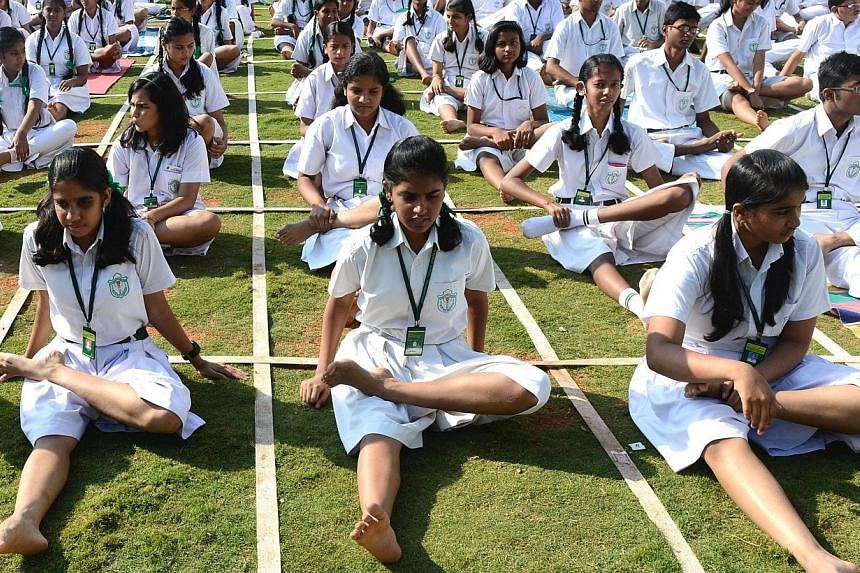This article was first published on Nov 16, 2014
When Mr Shripad Yesso Naik was appointed as India's minister for yoga, ayurveda and other traditional medicines as part of a Cabinet expansion last week, some people scoffed while a few breathed easy. Most were surprised.
Indians are already familiar with yoga. When yoga master Baba Ramdev was at the height of his fame in the early and mid-2000s, his fans could be seen rubbing their fingernails together while waiting at bus stops, performing an exercise he popularised on his TV shows and which he said stopped the greying of hair.
Even Bollywood actress Kareena Kapoor famously attributed her slim frame to yoga.
Does India then really need a minister for yoga, some asked.
"Promotion of yoga is good, but I don't know if it is as important a matter as to get a separate ministry," said Mr Anant Sandhu, director of Delhi Dance Academy, which conducts yoga classes for paying participants.
But with various types of yoga gaining popularity across the world, some fear the traditional practice as mentioned in ancient Indian scriptures is getting more elusive and diluted.
And the government seems to be on a mission to reclaim a heritage which has become equally, if not more, popular outside the country.
"This is our system and it has not received enough prominence. We will take it to the masses," said Mr Naik, who took charge of the ministry last Tuesday.
Prime Minister Narendra Modi, who decided to remove yoga and traditional medicines from the purview of Health Minister J.P. Nadda and put Mr Naik in charge of them, spoke about yoga in his maiden speech to the United Nations General Assembly in September.
"Yoga is not just about fitness or exercise, it is about changing one's lifestyle," Mr Modi, an avid fan of the practice, said.
His public reference on the world stage to yoga was meant to remind the international audience of its link with India, The Times of India opined.
India's UN mission has won the support of 130 countries for a draft resolution to declare June 21 as International Yoga Day. The next step is to adopt the resolution, with some reports saying it could happen as early as Dec 10.
Mr Modi, a vegetarian, spends an hour practising yoga every day from 5am. He is also a strong proponent of natural remedies.
India's attempt to cement its link to yoga has been going on for some time. In 2011, the government prepared a database of 1,300 yoga poses, videographed 200 of them, and sent it to international patent offices to prevent anyone taking out a patent on them.
At the Lonavla Yoga Institute in the state of Maharashtra, a non-profit organisation which has received government funding for research into yoga, research has been under way to dig out more poses and breathing techniques from ancient texts.
While many people in India, like in other parts of the world, take up yoga to lose weight and for greater flexibility, there is an equal number of people who practise yoga as a lifestyle choice.
Ms Kakoli Saha, a 40-year-old mother of one, who started doing yoga three years ago, hopes the ministry will help preserve yoga traditions.
"I am scared that if yoga becomes too popular, it will lose its essence like what is happening in the West. If you look at it as a physical thing just to lose weight, you are not getting the essence. It is an entire lifestyle and is about balance. It is about not over-indulging or over-consuming.
"I feel a sense of calm after a yoga class. When I am driving back home, I don't react to people driving badly like overtaking me or honking at me. I feel very peaceful," said Ms Saha, who attends a slow-paced meditative class offered by the Shivananda Yoga Vedanta Centre in Delhi.
Under the new Ministry of
Ayurveda, Yoga & Naturopathy, Unani, Siddha and Homoeopathy (abbreviated as Ayush), more focus will also be given to alternative and traditional therapies.
While the alternative medicine systems of homeopathy and ayurveda are well known across India, Unani, a form of medicine that was brought into India by the Mughal rulers, and Sidda, which uses flowers, fruit and roots in its medical preparations, are popular mainly in smaller cities.
The government has allocated 10.69 billion rupees (S$225 million) for the development and promotion of traditional health systems in the 2014-15 financial year, and there are hopes that more funding will be allocated next year.
The ministry plans to set up alternative medicine clinics in top hospitals and will look after research and development, monitor quality control and standardise the manufacturing of medicinal products of ayurveda and other traditional Indian treatment systems. Ayurveda relies exclusively on medicinal plants and herbs, and purified minerals.
The formation of the ministry comes days after the government announced it would set up a separate Drug Controller for traditional medicines to ensure quality in production.
India is hoping to better tap the global market for alternative medicine worth an estimated US$100 billion (S$130 billion).
Baba Ramdev, the saffron-clad bare-chested yoga guru who has millions of followers thanks to the televising of his yoga camps since 2003, has built an empire worth more than 11 billion rupees selling ayurvedic medicines, spices, soaps and shampoo.

